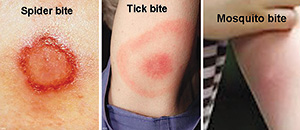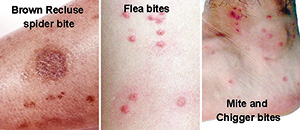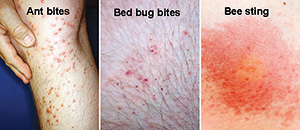What bit me? Identifying those bug bites
 What bit me? Identifying those bug bites
What bit me? Identifying those bug bites
Ow! What was that? Summertime is bug season. Getting bitten by a bug can be a creepy experience, especially if you don’t know what tiny creature left you with that red, throbbing welt on your skin.
Don’t panic. Most bites and stings from common insects are harmless and heal quickly. But some bites and stings, like those from fire ants, wasps, hornets and bees, may cause intense pain or even an allergic reaction. Others, like poisonous spider bites, require immediate emergency medical care.
 Mosquitoes may be small and have short lifespans (Males usually live for about a week, while females can live for a few months), but they can wreak havoc on human lives. From their itchy bites to the diseases they can carry, Mosquitoes are often annoying and sometimes downright deadly.
Mosquitoes may be small and have short lifespans (Males usually live for about a week, while females can live for a few months), but they can wreak havoc on human lives. From their itchy bites to the diseases they can carry, Mosquitoes are often annoying and sometimes downright deadly.
Symptoms of bug bites provide clues to the cause and severity. For example, most bug bites cause red bumps with pain, itching, or burning. Some bug bites also feature blisters or welts.
 Tick bites can carry Lyme disease with a rash that looks like a bull’s-eye. Most bug bites are transmitted directly from the insect, and most bug bites occur outdoors. Two exceptions are bedbugs — tiny mites that live in and near beds — and lice, which spread through contact with an infected person, a comb, or clothing.
Tick bites can carry Lyme disease with a rash that looks like a bull’s-eye. Most bug bites are transmitted directly from the insect, and most bug bites occur outdoors. Two exceptions are bedbugs — tiny mites that live in and near beds — and lice, which spread through contact with an infected person, a comb, or clothing.
The best way to prevent insect bites is to avoid insects, wear protective clothing, use pesticide, not eat foods or wear fragrances that attract bugs, and know your own personal risk for having an allergic reaction to a bug bite.
Because certain bites can also spread illnesses such as the Zika virus and West Nile virus (both transmitted by a mosquito), Lyme disease (from a black-legged tick), Rocky Mountain spotted fever (from a dog or wood tick), or Chagas disease (from kissing bugs), it’s good to know what bit you. Learning to identify a bug bite by how it looks and feels will help you know whether to seek medical care or treat the skin bump at home.
 DANGEROUS BUGS
DANGEROUS BUGS
Most of us develop redness and swelling at the site of an insect bite. Yet people who are allergic to stinging insect venom are at risk for a much more serious reaction. This life-threatening reaction is called anaphylaxis.
Understanding differences in symptoms between a normal reaction and an allergic reaction can bring peace of mind. It is also important to have an accurate diagnosis so you can manage your condition and be prepared for an emergency.
An allergic reaction occurs when the immune system overreacts to an allergen. In a stinging insect allergy, the allergen is venom from a sting. Most serious reactions are caused by five types of insects:
- Yellow jackets are black with yellow markings, found in various climates. Their nests are usually located underground, but sometimes found in the walls of buildings, cracks in masonry or in woodpiles.
- Honeybees have round, fuzzy bodies with dark brown and yellow markings. They can be found in honeycombs in trees, old tires or other partially protected sites.
- Paper wasps are slender with black, brown, red and yellow markings. They live in a circular comb under eaves, behind shutters or in shrubs and woodpiles.
- Hornets are black or brown with white, orange or yellow markings. Their nests are gray or brown and are usually found in trees.
- Fire ants are reddish-brown ants living in large mounds, mostly in warmer climates. They attack with little warning, inserting highly concentrated toxins that cause burning and pain.
FIRST AID FOR BITES AND STINGS
Wash the affected area with soap and water. Apply a cold compress (such as a flannel or cloth cooled with cold water) or an ice pack to any swelling for at least 10 minutes. Raise or elevate the affected area if possible, as this can help reduce swelling.
For bites that itch, apply an ice pack or an over-the-counter anti-itch cream, such as hydrocortisone. Another option is to take an over-the-counter oral antihistamine. To reduce swelling, apply an ice pack to the bite.



Leave a Reply